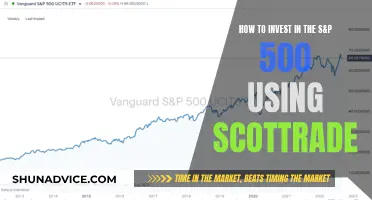
Direct investing is a great way to take control of your financial future. With the right tools and resources, you can make informed investment decisions and work towards your financial goals, whether you're a beginner or an experienced trader. Direct investing platforms offer a range of investment options, from stocks and ETFs to mutual funds and fixed-income investments, giving you the flexibility to build a diverse portfolio. You can also choose from different types of accounts, such as Tax-Free Savings Accounts (TFSAs) and Registered Retirement Savings Plans (RRSPs), each offering unique tax advantages. By utilising real-time market data, analyst insights, and advanced trading tools, you can make strategic investment decisions with confidence. Additionally, direct investing platforms often provide educational resources and practice accounts, allowing you to enhance your investing knowledge and skills in a risk-free environment. With their user-friendly interfaces and comprehensive features, direct investing platforms empower individuals to take charge of their financial journey.
| Characteristics | Values |
|---|---|
| Tools | Real-time streaming quotes, portfolio analyzers, practice accounts, screeners and picklists, pre-authorized contributions, technical analysis and advanced charting tools |
| Resources | Industry insights, curated content, educational resources, research reports, investment seminars, newsletters |
| Investment Options | Exchange-Traded Funds (ETFs), mutual funds, stocks, options, rights, warrants, fixed-income investments, gold and silver certificates |
| Account Types | Tax-Free Savings Account (TFSA), Registered Retirement Savings Plan (RRSP), Cash Account, Margin Account, Self-Directed Accounts |
| Pricing | Trade commissions vary based on trade activity and type of trade |
| Platforms | Online, mobile, advanced dashboards, TD App, WebBroker |
| Transfer Fees | Reimbursement offered for transfer fees when switching to TD |
What You'll Learn

Understand your options before investing
Before you start investing, it's crucial to understand your options and choose the right investment accounts and products that align with your financial goals and needs. Here are some key considerations to help you make informed decisions:
Investment Accounts:
- Tax-Free Savings Account (TFSA): A TFSA is ideal for saving towards any goal, as it offers tax-free benefits. You don't pay taxes on capital gains, dividends, interest, or withdrawals. This means you can grow your savings without worrying about tax implications.
- Registered Retirement Savings Plan (RRSP): If you're focusing on retirement planning, an RRSP is a great option. It allows you more freedom and control over your retirement savings. You can invest in different assets, such as stocks or GICs, and contributions are tax-deductible.
- Cash Account: A cash account offers easy access to your money and is suitable for those who want to buy and sell without restrictions.
- Margin Account: A margin account lets you leverage your investments by borrowing funds from a brokerage firm to purchase securities. It's essential to understand the risks and potential benefits associated with margin accounts before considering this option.
Investment Products:
- Exchange-Traded Funds (ETFs): ETFs are ideal if you want a diversified portfolio. They trade on stock exchanges and can be bought and sold at any time during the trading day. ETFs provide real-time performance updates and often have lower fees than mutual funds.
- Mutual Funds: Mutual funds offer built-in diversification and are managed by a fund manager. They are suitable if you want a pre-selected or tailored portfolio of securities. However, they typically have higher management fees and may have early redemption fees.
- Stocks: Investing in stocks gives you ownership in a company and entitles you to a share of its profits. You can choose between Canadian and U.S. stocks, common or preferred shares, depending on your risk tolerance and investment strategy.
- Options: Options give you the right to buy or sell a security at a specific price within a certain period. They can provide flexibility and leverage in your investment strategy.
- Fixed-Income Investments: These include T-bills, bonds, and GICs, which offer stable and predictable returns. They are suitable for more conservative investors seeking regular income.
Remember, it's important to carefully consider your financial goals, risk tolerance, and time horizon before choosing any investment option. Conduct thorough research, understand the fees and potential risks associated with each investment type, and seek professional advice if needed to make informed decisions.
Ethereum to Ripple: A Guide to Converting Your Crypto
You may want to see also

Choose the right account for your needs
When it comes to direct investing, choosing the right account for your needs is essential. Here are some things to consider when making your decision:
Account Type
First, you need to decide what type of account you want to open. There are typically two main types of accounts: personal and non-personal. Personal accounts are usually used for individual investors, while non-personal accounts are designed for organizations or businesses. Within these categories, there are also various subtypes, such as cash accounts, margin accounts, registered accounts, and non-registered accounts. Each type of account has its own advantages and is suitable for different investment goals.
Investment Options
Different accounts offer different investment options. For example, with a self-directed account, you can hold stocks, exchange-traded funds (ETFs), mutual funds, bonds, and other investments. In contrast, certain accounts may be limited to specific types of investments, such as stocks and ETFs only. Consider what types of investments you want to make and choose an account that aligns with your preferences.
Fees and Commissions
Section: Fees and commissions are important factors when choosing an investment account. Some accounts charge maintenance fees, while others may have higher trading commissions. Look for accounts that offer competitive pricing and ways to reduce fees, such as waiving fees based on your account balance or trading activity. Additionally, consider the impact of taxes on your investments and choose accounts that offer tax advantages, such as tax-free savings accounts (TFSAs) or registered retirement savings plans (RRSPs).
Platform and Tools
The investment platform you choose should provide the tools and resources you need to make informed investment decisions. Look for platforms that offer real-time market data, analyst insights, and research reports. Also, consider the level of investor you are—beginner, active, or advanced—and choose a platform that caters to your skill level, providing the necessary educational resources and guidance.
Accessibility and Flexibility
Choose an account that gives you easy access to your money and provides flexibility in managing your investments. For example, some accounts allow you to invest in Canadian and US markets, giving you a broader range of investment options. Additionally, consider the ease of setting up and transferring funds to your account.
Security and Protection
Finally, when choosing a direct investing account, ensure that your funds are secure. Look for platforms that offer guarantees or reimbursements for unauthorized transactions. This will give you peace of mind and protect your investments.
Remember, it is important to do your research and understand the features and limitations of each account type before making your decision. Carefully consider your investment goals, risk tolerance, and financial situation when choosing the right account for your needs.
Cashing in on Treasury Investment Growth: Receipt Redemption Guide
You may want to see also

Diversify your portfolio
Diversifying your portfolio is a crucial aspect of investment planning, enabling you to manage risk and enhance returns. Here are some strategies to diversify your portfolio effectively:
Diversify Across Asset Classes:
Diversification goes beyond stocks and bonds. Explore alternative investments such as private equity, hedge funds, venture capital, real estate, commodities, and more. These alternatives often have a low correlation with traditional assets, providing a hedge against market downturns.
Geographic Diversification:
Avoid the "home-country bias" by investing internationally. Investing in various regions helps reduce concentration risks associated with localized economic downturns, currency devaluations, and political instability in your home country. It also broadens your investment opportunities beyond your domestic market.
Sector and Industry Diversification:
Different sectors and industries experience varying economic conditions and business cycles. By diversifying across sectors, you reduce the impact of a single sector's performance on your portfolio. For instance, real estate may benefit from low-interest rates, while other sectors may be more sensitive to interest rate changes.
Time Horizon and Risk Tolerance:
Consider your investment goals and risk tolerance. If you have a longer time horizon, you can explore riskier assets with higher potential returns. As you approach your goals, shift towards less volatile assets like bonds to preserve capital.
Individual Asset Diversification:
Within each asset class, spread your investments across different industries. For instance, invest in a mix of pharmaceuticals, education technology, and information technology rather than focusing solely on one sector.
Periodic Rebalancing:
Monitor your portfolio regularly and rebalance it to maintain your desired risk level. Over time, the performance of individual assets will cause deviations from your intended asset allocation. By rebalancing, you can lock in gains and adjust your portfolio back to your target allocation.
Understand Global Markets:
Educate yourself about global market dynamics, trends, and fluctuations. This knowledge will help you make more informed decisions when investing internationally.
Know Your Financial Biases:
Be aware of the factors that may influence your investment decisions, such as risk aptitude, family attitudes, cultural beliefs, and luck. Understanding these biases can help you make more rational and objective investment choices.
Explore Disciplined Investment Schemes:
Consider disciplined investment approaches like Systematic Investment Plans (SIPs) or Systematic Withdrawal Plans (SWPs). These schemes encourage regular, disciplined investing and provide access to mutual funds with low initial investment requirements.
Monitor Costs and Fees:
Keep track of trading and portfolio management fees, as these can eat into your investment returns. Opt for investments with lower fees to maximize your gains over time.
Remember, diversification is a highly personalized strategy that depends on your financial goals, risk tolerance, and time horizon. It's essential to periodically review and adjust your portfolio to ensure it aligns with your investment plan.
How Investments Can Drain Your Cash Reserves
You may want to see also

Make informed trades
Making informed trades is an essential aspect of direct investing. Here are some key considerations for those looking to make informed trades:
Access to Information and Research:
Direct investing platforms should provide users with access to real-time market data, quotes, and advanced charting tools. This includes tracking stock and ETF prices, pre-market and after-hours trading data, and analyst insights. These tools enable investors to make data-driven decisions and stay ahead of the market.
Analysis of Real-World Events:
Understanding how global events and situations impact investments is crucial. Direct investing platforms often offer tools to help investors identify these connections. For example, tracking tools can help investors see how real-world events influence their portfolios, allowing them to make more informed trades.
Diversification and Risk Management:
Diversifying your portfolio across various assets and markets can help manage risk. Direct investing platforms may offer a range of investment options, such as stocks, bonds, ETFs, mutual funds, and more. By diversifying, investors can reduce the impact of market fluctuations on their portfolios.
Practice and Education:
Making informed trades requires knowledge and experience. Direct investing platforms often provide educational resources, tutorials, and even practice accounts. These tools allow investors to simulate trading without risking real money, helping them improve their skills and test strategies before entering the market.
Technical Analysis and Charting:
Technical analysis involves studying historical market data, such as price movements and trading volumes, to identify patterns and trends. Direct investing platforms often provide advanced charting tools to facilitate this analysis, helping investors make more informed decisions about entry and exit points, as well as identify potential trading opportunities.
In summary, making informed trades through direct investing requires access to information, analytical tools, and educational resources. By leveraging the features provided by direct investing platforms, investors can improve their decision-making abilities, better manage risk, and ultimately enhance their overall trading performance.
Computing Net Proceeds: Investing Cash Flow Explained
You may want to see also

Monitor your investments
Monitoring your investments is an important part of direct investing. Here are some ways to monitor your investments to ensure you meet your financial goals:
Create a Financial Plan
Before investing, it is important to create a financial plan that outlines your goals and the level of risk you are comfortable taking. Your plan should include the types of investments you want to make (e.g. stocks, bonds, cash) and the appropriate allocations needed to meet your goals while staying within your risk tolerance.
Look at the Whole Picture
It is common to have investments spread across multiple accounts, including current and old 401(k) plans, individual retirement accounts (IRAs), and brokerage accounts. Therefore, it is crucial to review your investments as a total portfolio across all your accounts to ensure your overall allocation is in sync with your financial plan.
Establish Benchmarks
Set up benchmarks to help you determine if you are on track with your investments. For example, if your allocation is 50% stocks and 50% bonds, you might use the Russell 3000 Index and the Barclays Aggregate Bond Index as benchmarks. Track your overall accumulation progress against the goals in your financial plan and compare your individual holdings against appropriate benchmarks.
Evaluate Your Individual Holdings
Once you have assessed your overall allocation and performance against benchmarks, take a closer look at your individual holdings. Compare mutual funds and ETFs against market benchmarks and peer group measurements, and assess individual stocks against an appropriate market index.
Monitor Regularly
The frequency with which you review your investments depends on your financial goals and investment timeframe. Defensive assets, such as savings accounts, term deposits, and bonds, can be checked more frequently when you receive a statement. Growth assets, such as property, shares, and managed funds, are more volatile and are typically reviewed once or twice a year, such as when semi-annual and annual reports are released.
Utilize Online Tools and Apps
Various online tools and apps can help you monitor your investments, such as Personal Capital, Ticker, Ellevest, Morningstar, and Google Finance. These tools allow you to track your financial activities, net worth, portfolio performance, and investment allocations.
Get Professional Help
If you feel uncomfortable monitoring your investments yourself or want a second opinion, consider hiring a professional financial adviser. They can provide objective advice and guidance tailored to your specific needs and goals.
Cash-Rich Investments: Strategies for Financial Freedom
You may want to see also
Frequently asked questions
You can open an online trading account by visiting the Open an Account page. Your application will be approved in as little as 24 hours.
You can choose from Canadian and U.S. stocks, common and preferred shares, new issues, options, rights and warrants, mutual funds, exchange-traded funds (ETFs) and fixed-income investments such as T-bills, bonds and GICs.
There are a few ways to save on fees. Firstly, RBC Direct Investing offers a waiver on the maintenance fee when you hold combined assets of $15,000 or more across your RBC Direct Investing accounts. Another way is to set up a Pre-Authorized Contribution Plan of at least $100 per month ($300 per quarter).







